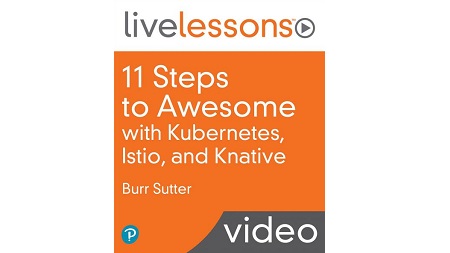
English | MP4 | AVC 1280×720 | AAC 44KHz 2ch | 6h 30m | 3.38 GB
11 Steps to Awesome with Kubernetes, Istio, and Knative LiveLessons (Video Training) – Introduction, Master Your Microservices, Learn the why behind Linux Containers
Orchestrate containers with Kubernetes, Get your tools for the journey, Use minikube & kubectl, Use docker with minikube, Learn tips and tricks
Create Namespaces, Create Pods, Create ReplicaSets, Create Deployments, Create Services, Add Labels, Manipulate Services
Craft a Dockerfile, Add Jib, Explore alternatives to ‘docker build’, Use image repositories
Watch logs, Explore the shell – kubectl exec, Constrain CPU_memory resources, Create ConfigMaps, Create Secrets
Use service discovery, Configure Liveness and Readiness Probes, Deploy Blue_Green, Store data with PersistentVolume and PersistentVolumeClaim
Discover CustomResourceDefinitions, Add Pizzas to your Kubernetes Cluster, Understanding Controllers, Discover Operators
Understand Microservices architecture requirements and challenges, Install Istio, Deploy with Istio_Envoy Sidecars, Shift traffic with VirtualService and DestinationRule, Perform smarter canary deployments, Practice mirroring and the dark launch
Explore observability – Grafana, Jaeger, Kiali, Inject Chaos, Add resiliency, Add security
Understand serverless, Learn Knative serverless capabilities for Kubernetes, Learn Knative Serving, Prepare and deploy a Knative Service, Autoscaling HTTP
Use Knative Eventing, Create a Cron Service, Create an Apache Kafka Service, Steps to Awesome with Kubernetes, Istio, and Knative LiveLessons (Video Training) – Summary
Table of Contents
01 11 Steps to Awesome with Kubernetes, Istio, and Knative LiveLessons (Video Training) – Introduction
02 Learning objectives
03 1.1 Master Your Microservices
04 1.2 Learn the why behind Linux Containers
05 Learning objectives
06 2.1 Orchestrate containers with Kubernetes
07 2.2 Get your tools for the journey
08 2.3 Use minikube & kubectl
09 2.4 Use docker with minikube
10 2.5 Learn tips and tricks
11 Learning objectives
12 3.1 Create Namespaces
13 3.2 Create Pods
14 3.3 Create ReplicaSets
15 3.4 Create Deployments
16 3.5 Create Services
17 3.6 Add Labels
18 3.7 Manipulate Services
19 Learning objectives
20 4.1 Craft a Dockerfile
21 4.2 Add Jib
22 4.3 Explore alternatives to ‘docker build’
23 4.4 Use image repositories
24 Learning objectives
25 5.1 Watch logs
26 5.2 Explore the shell – kubectl exec
27 5.3 Constrain CPU_memory resources
28 5.4 Create ConfigMaps
29 5.5 Create Secrets
30 Learning objectives
31 6.1 Use service discovery
32 6.2 Configure Liveness and Readiness Probes
33 6.3 Deploy Blue_Green
34 6.4 Store data with PersistentVolume and PersistentVolumeClaim
35 Learning objectives
36 7.1 Discover CustomResourceDefinitions
37 7.2 Add Pizzas to your Kubernetes Cluster
38 7.3 Understanding Controllers
39 7.4 Discover Operators
40 Learning objectives
41 8.1 Understand Microservices architecture requirements and challenges
42 8.2 Install Istio
43 8.3 Deploy with Istio_Envoy Sidecars
44 8.4 Shift traffic with VirtualService and DestinationRule
45 8.5 Perform smarter canary deployments
46 8.6 Practice mirroring and the dark launch
47 Learning objectives
48 9.1 Explore observability – Grafana, Jaeger, Kiali
49 9.2 Inject Chaos
50 9.3 Add resiliency
51 9.4 Add security
52 Learning objectives
53 10.1 Understand serverless
54 10.2 Learn Knative serverless capabilities for Kubernetes
55 10.3 Learn Knative Serving
56 10.4 Prepare and deploy a Knative Service
57 10.5 Autoscaling HTTP
58 Learning objectives
59 11.1 Use Knative Eventing
60 11.2 Create a Cron Service
61 11.3 Create an Apache Kafka Service
62 11 Steps to Awesome with Kubernetes, Istio, and Knative LiveLessons (Video Training) – Summary
Resolve the captcha to access the links!